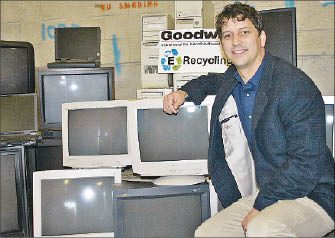
Home » Goodwill nets multiple benefits from E-Cycle program
Goodwill nets multiple benefits from E-Cycle program
Manufacturer-funded electronics recycling exceeds expectations

December 10, 2009
An electronics recycling program launched in Washington state this year has proven to be a boon to its nonprofit collectors, including Goodwill Industries of the Inland Northwest, which is one of the major collectors for the program in Eastern Washington.
Goodwill says it has collected 1.5 million pounds of such waste, including everything from televisions to computers, through November this year, more than double the 600,000 pounds it had expected to collect in the first year of the program. Statewide, the program, called E-Cycle, had collected 33 million pounds of electronic waste through October.
The service is free for residents, small businesses with fewer than 50 employees, schools and school districts, charitable organizations, special-purpose districts such as health districts, and small governmental units that drop off old electronics for recycling. Goodwill has an agreement with Spokane Public Schools, for example, to pick up all of the district's computers at the end of their useful life. They are either recycled through the E-Cycle program, or used to train students in computer refurbishing through a program called TEConnections. The school district says it has saved between $30,000 and $50,000 so far because it hasn't had to pay a private processor to remove unwanted equipment, thanks to the E-Cycle program.
The E-Cycle program was launched in January and is the result of a state law passed in Washington in 2006. The law requires manufacturers of certain categories of electronics that sell those products in the state to pay for the recycling of those products, says Miles Kuntz, a Washington state Department of Ecology spokesman.
"It's a pretty big hammer," Kuntz says. "If you want to sell in the state, you have to participate in the recycling of the products."
The Department of Ecology regulates the program, but it's operated by a Woodland, Wash.-based organization the industry has set up, named the Washington Materials Management and Financing Authority (WMMFA). The organization bills manufacturers based on their market share and how much of what they sell potentially can go into the recycling stream, Kuntz says. Before the program was launched, most old electronics equipment wound up in landfills or incinerators, and many electronics, particularly televisions and computers, contain toxic substances such as lead, cadmium, and mercury. Recycling electronics keeps toxic materials out of landfills and incinerators and recovers valuable resources, Kuntz says.
So far this year, the program has billed its 200 manufacturer members $10.5 million, about $500,000 of which was returned to Washington state to repay a start-up loan for the program.
The WMMFA contracts with collectors and transporters to collect and ship recyclable materials to processing plants. Throughout the state, there are about 230 collection sites, about half of which are operated by nonprofit organizations, including Goodwill and the Salvation Army, Kuntz says.
Under their agreements, the collectors are authorized to pull anything still usable from the recycling stream and refurbish or resell it on their own, he says.
"They are happy to be part of the program and getting paid for that, and in addition they are getting good material that can be resold," he says.
Clark Brekke, president and CEO of Goodwill here, says the organization has been able to pull about 20 percent of the electronic materials it collects, most of which are television sets. An even more significant benefit for collectors such as Goodwill, however, is the reduction of waste fees it would pay otherwise to dump the unusable electronics it often receives, he says.
Brekke says that Goodwill applied to be part of the program because it was a natural fit with what it already was doing.
"Since we were already equipped to collect and ship the material, it's a solid way to support our donors with convenience and our community with such a huge reduction in e-waste," he says.
In addition, the program fits with Goodwill's organizational values of reusing and recycling, and doesn't place a burden on taxpayers, he says.
"Participating in a program that greatly reduces electronic waste without having a negative impact on our taxpayers or our organizational resources aligns very well with our corporate values," Brekke says.
Before the recycling program was launched, many of the electronics the organization received as donations were unusable and had to be disposed of, part of the company's $500,000 annual waste bill, says Diane Galloway, a Goodwill spokeswoman. With the recycling program, however, Goodwill has been able to reduce its disposal fees by about $42,400 so far this year, as well as getting paid by the pound for the recyclable electronics that it collects and ships to one of three "demanufacturing" facilities on the West side.
There, they are broken down into their components—different types of glass, steel, aluminum, and plastics—and for the most part returned to the commodities market to be recycled into different products, Kuntz says.
When electronic waste is turned in at any one of Goodwill's 12 collection sites here, it is presorted by experienced people who set aside items clearly headed for the recycling program and keep track of the weight and categories of the materials Goodwill collects, so that it can bill the program, Galloway says.
There are always at least three disabled or disadvantaged people getting work assessment training in the E-Cycle program, Galloway says. While they learn marketable skills and Goodwill's staff assesses their work readiness, most also are paid a wage, she says. Altogether, Goodwill of the Inland Northwest employs 540 people and provides pre-employment, job-placement, and other services to more than 2,700 people each year.
Latest News
Related Articles



